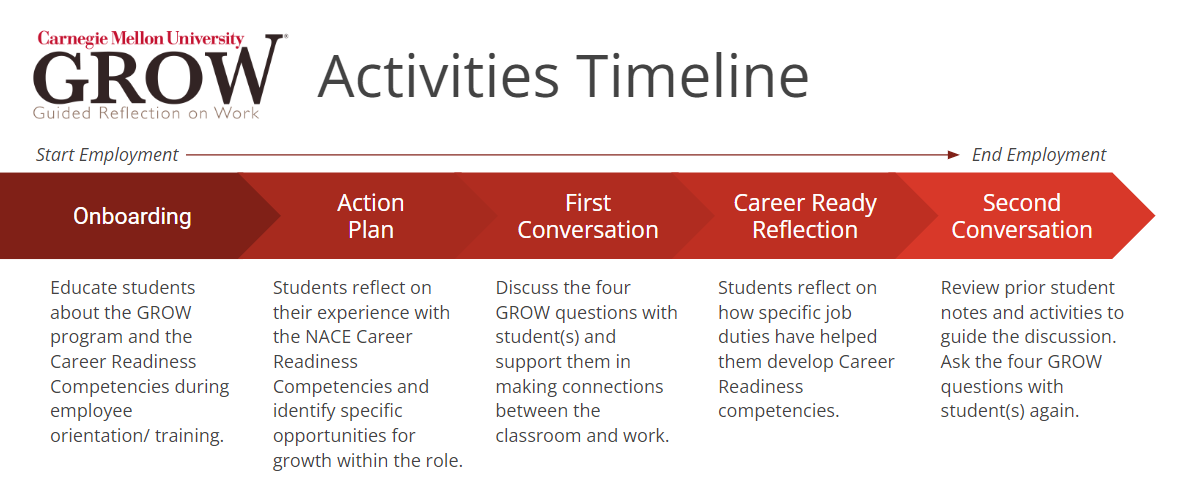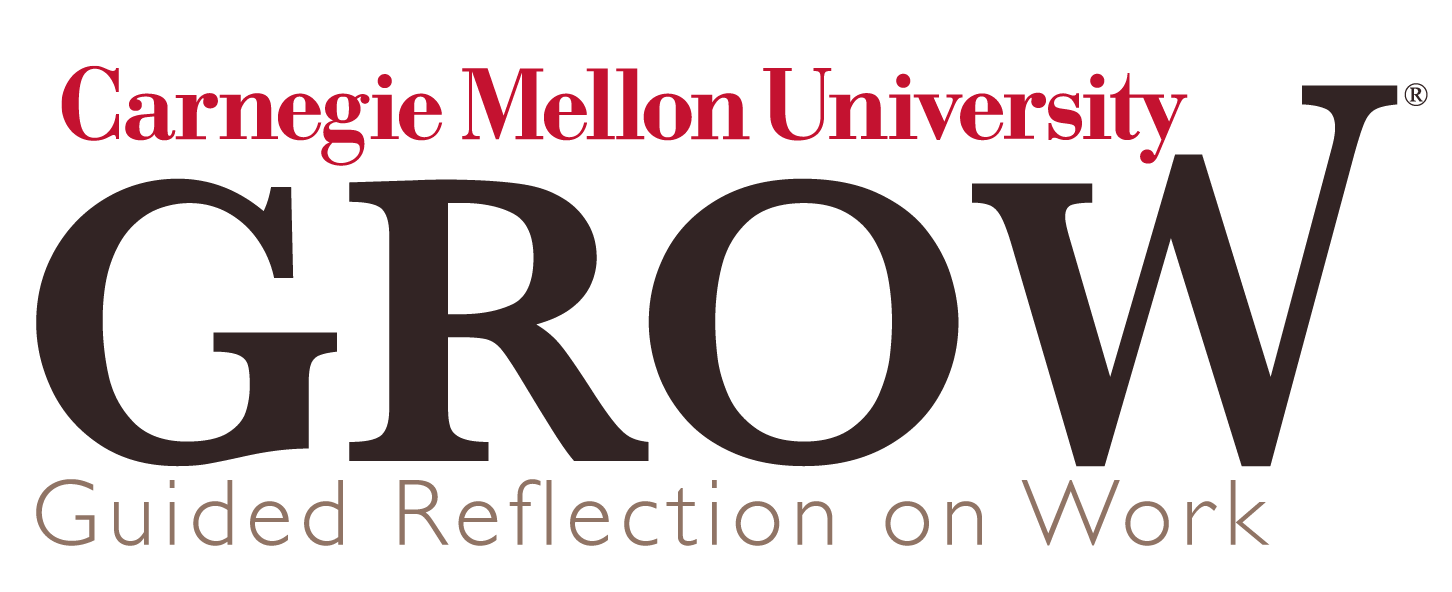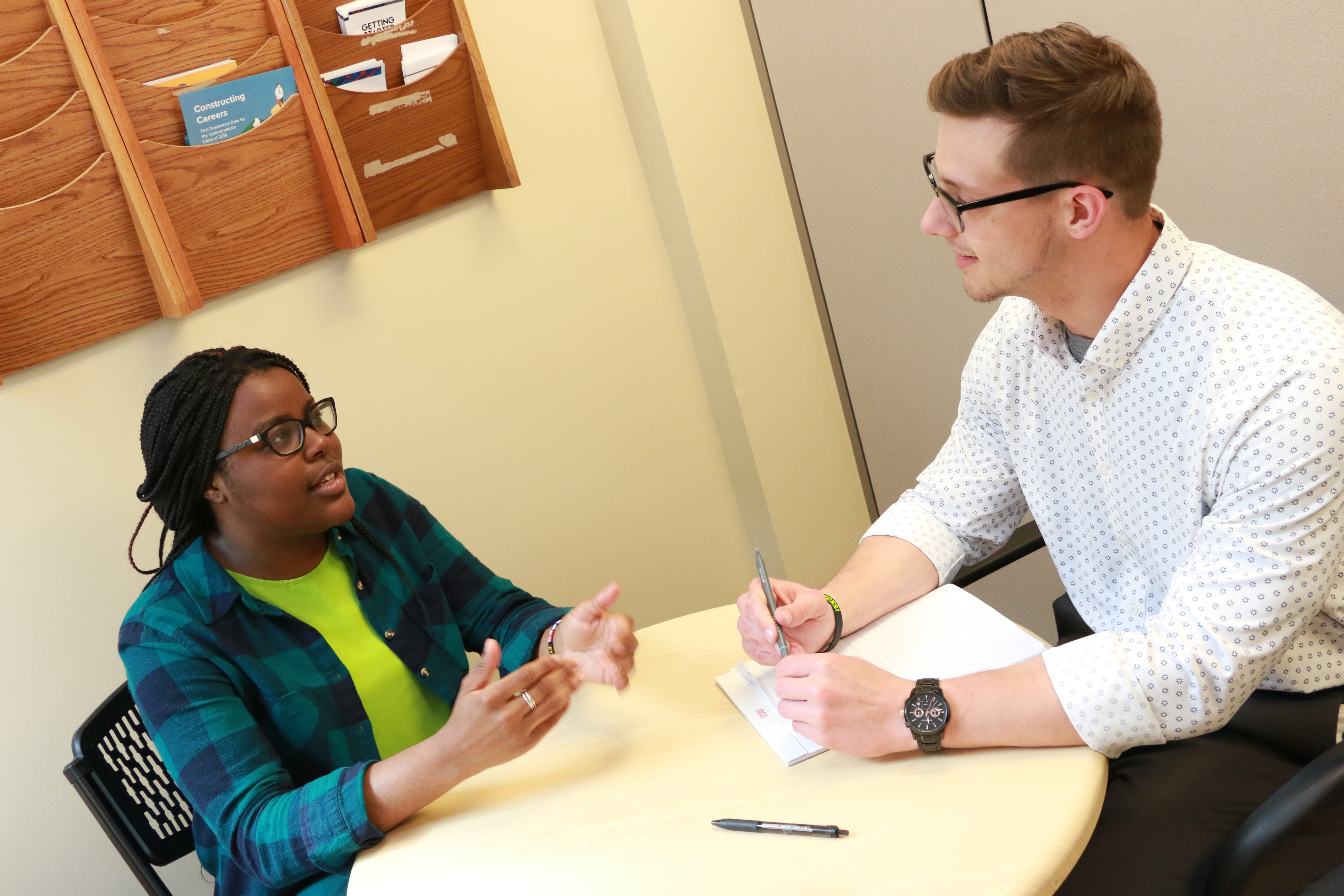Supporting Career-Readiness
On-campus employment provides a significant opportunity for students to gain on-the-job experience and develop transferable skills that employers value. Supervisors can support students in their competency development by helping students make connections between work, academics, and their career development.
The CMU-GROW model provides a framework for brief, structured conversations between students and supervisors that allow students to reflect on their work and establish an action plan focused on career-readiness competencies, such as collaboration and teamwork, communication, information and data literacy, and intercultural and global literacy. During these conversations, supervisors ask their student staff four quick questions:
1. How is this job fitting in with your academics?
2. What are you learning here that's helping you in school?
3. What are you learning in class that you can apply here at work?
4. What have you learned here that you think you'll use in your chosen profession?
The GROW model is grounded in research on student learning and cognition, which shows that knowledge is more fully incorporated when it is transferred and applied across different contexts. By helping students reframe their views of their employment experience by connecting it to what they are learning in the classroom, supervisors can support high-quality reflection and learning transfer.
CMU-GROW is considered to be a high-impact educational practice, as it makes the learning that's occurring at the job more visible to students and gives them valuable practice transferring and applying the skills in different settings, contributing to the student's overall academic growth and success.
GROW was created by the University of Iowa in 2009 and more than 150 schools use the model with student staff on their campuses.
Goals of CMU-GROW:
- To advocate for student employment as a high-impact educational experience
- To enhance student learning in the workplace by providing opportunities for reflection and professional development
- To support and engage supervisors of student employees in their role as mentors and teachers of students
How CMU-GROW Works
CMU-GROW Conversations occur twice during the course of employment. In addition to helping students make connections between work and academics, the CPDC has supplemented the GROW model with instructions, activities, and tools that allow supervisors to gain important insights into their students’ competency development.

The timeline above outlines 5 activities that allow supervisors to engage their students in reflection and growth throughout the course of their employment period. The specific timing of each activity will vary depending on supervisor preferences and employment start/end dates. See below for more specific instructions for each activity.
Onboarding
Fill out the Student Employee Roster before beginning. This allows the CPDC GROW team to track individual student development and provide you with a report at the end of the year. You can edit this form whenever you have a new hire or a student that leaves the position.
Schedule GROW Onboarding into your staff orientation agenda. This should be implemented as part of the student's general orientation, whether that be in a group or individual setting. This can also be conducted during a meeting separate from orientation. A discussion about CMU-GROW and what to expect should take anywhere from 10-15 minutes.
Explain roles and expectations of the student's position. Focus on daily tasks, projects, interactions, and any other roles or responsibilities of the job. You likely already planned to discuss these responsibilities during orientation, but be sure to be very clear about what these responsibilities entail.
Provide an overview of the GROW program. Use the information presented above in the "About CMU-GROW" section to inform students of the conversations, the four questions, and activities to expect throughout the employment period. The goal is to help students understand that by participating in these activities, they can better recognize and hone the transferable skills and competencies that they're picking up on the job and in class. This will help prepare them for the job search and professional world.
Introduce Career Readiness Competencies definitions. The NACE Career Competencies provide supervisors with a carefully crafted list of transferable skills that can be the focus of their conversations with students. Be sure to define each of the competencies so that students have an accurate understanding. It is helpful to provide examples of how a person could apply each competency/skill (example behaviors are provided on NACE's website).
Inform students of Action Plan (share with students during orientation or send afterward). Ask each student worker to complete a personal Action Plan in order to leverage job responsibilities for skill development. This can be done during or after orientation.Student Action Plan
- To be completed by students: Supervisors can use the Action Plan as an activity during orientation/onboarding, or choose to send it afterward (Click here for email template). It is recommended that students record their answers via the online survey provided so supervisors can access and review responses when needed.
- The purpose of the Action Plan is to allow students to consider their level of confidence with each of the Career Readiness Competencies, identify a particular competency to improve, and establish a plan for doing so through the work required in their on-campus job. This activity provides the supervisor with a baseline for competency development and allows the supervisor to know what competencies their employees plan on developing further.
Conversation #1
Before the CMU-GROW Conversation
Schedule GROW meeting(s) and brief staff. Determine whether individual or small group meetings work best for your student staff and schedule meeting time(s). Brief your staff in person or send them an email a week before your meeting.
Note on Group Conversations: We recommend that you allocate about 30 minutes and limit groups to a maximum of eight students, to ensure each student has space to speak and listen to others.
Review your student employees' Action Plans: Prior to meeting, reviewing the student's Action Plan and any other conversation notes taken will help the supervisor guide the conversation.
During the CMU-GROW Conversation
Restate the purpose of the conversation to the student. The purpose is to connect academics with their work experience, which both contributes to their academic success and prepares them to share their experiences with potential employers.
Ask the 4 GROW questions: Feel free to ask the questions in your own words and in any order, and let the conversation flow naturally. Approach these questions as if you are having a conversation, and not an interview. The 4 GROW questions are:
1. How is this job fitting in with your academics?
2. What are you learning here that is helping you in school?
3. What are you learning in class that you can apply here at work?
4. What have you learned here that you think you'll use in your chosen profession?
Contribute: If a student needs help answering, feel free to share your ideas or observations on what they are learning on the job; you can refer to their initial action plan, their competency reflection, or notes from the previous conversation.
Use/Take Notes to refer to in the future. You may find it useful to record competencies that the student focused on as well as identifying general or recurring themes. We recommend you record your notes using the templates provided to you in CMU-GROW training so you can easily refer to them.
Wrap up the conversations by reminding your student staff that you will be meeting again near the end of their employment for a similar conversation.
Refer (if necessary): Make recommendations for any other academic or student services staff that could be helpful. Refer to the campus resources in case a student indicates the need for extra help.
Student Career Readiness Reflection
To be completed by the student before the Second Conversation. This activity prompts students to reflect on the competencies they have developed through carrying out their job responsibilities. It is recommended that students record their answers via the Google Form provided to you in CMU-GROW training so supervisors can access and review responses when needed.
Conversation #2
Before the Conversation
Schedule GROW meeting(s) and brief staff: Determine whether individual or small group meetings work best for your student staff and schedule meeting time(s). Brief your staff in person or send them an email a week before your meeting.
For Small Group Conversations: We recommend that you allocate about 30 minutes and limit groups to less than 8, to ensure each student has space to speak and listen to others.
Review your notes from the first Conversation and Student's Action Plan: Prior to meeting, reviewing the student's Action Plan and any other conversation notes taken will help the supervisor guide the conversation.
During the CMU-GROW Conversation
Restate the purpose of the conversation to the student: to connect academics with their work experience which contributes to their academic success and prepares them to share their experiences to employers. Review notes from the previous conversation.
Ask the 4 GROW questions: Refer to the facilitation tips in this packet for techniques specific to having an effective conversation. Approach these questions as if you are having a conversation, and not an interview. Feel free to ask the questions in any order and let the conversation flow naturally.
1. How is this job fitting in with your academics?
2. What are you learning here that's helping you in school?
3. What are you learning in class that you can apply here at work?
4. What have you learned here that you think you'll use in your chose profession?
Contribute: If a student needs help answering, feel free to share your ideas or observations on what they are learning on the job; you can refer to their initial action plan, their competency reflection, **or notes from the previous conversation**.
Use/Take Notes to refer to in the future. You may find it useful to record competencies that the student focused on as well as identifying general or recurring themes. We recommend you record your notes using the templates below so that you can easily refer to them:
CMU-GROW Notes Template (Google Form) (Printable PDF)
Refer (if necessary): Make recommendations for any other academic or student services staff that could be helpful. Refer to the campus resources in case a student indicates the need for extra help.
Inform Student of the GROW Assessment Survey: They will be receiving an email from the Career and Professional Development Center regarding their experience.

